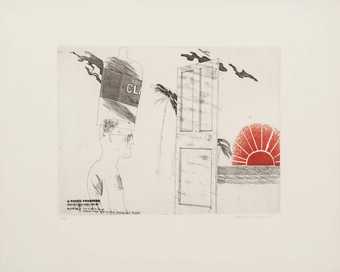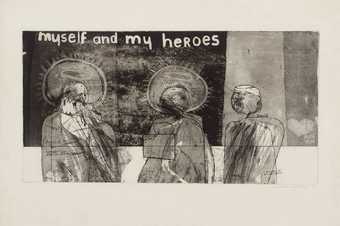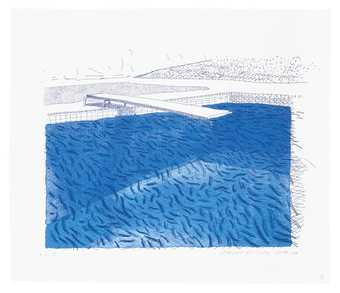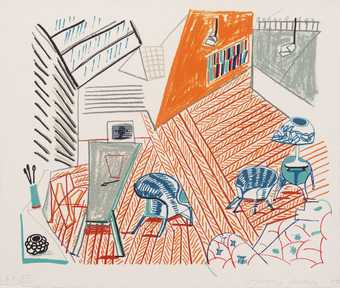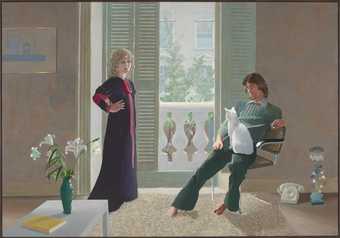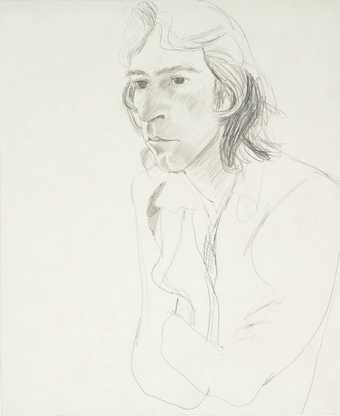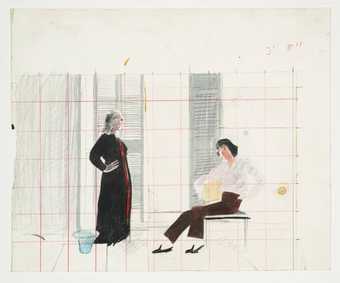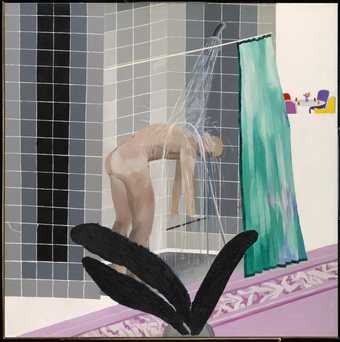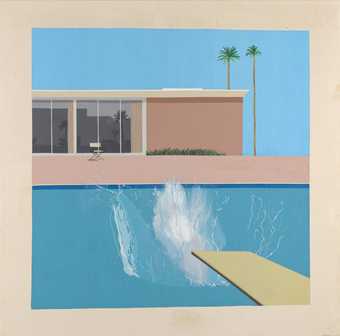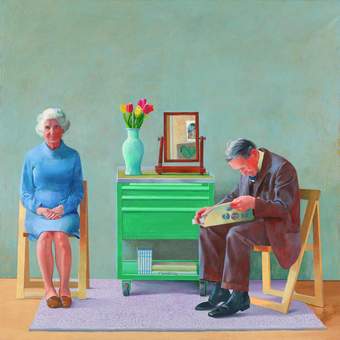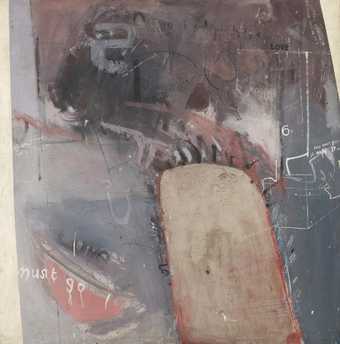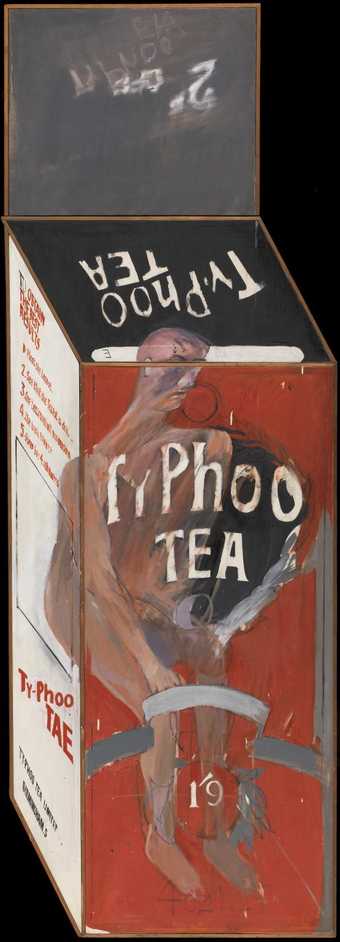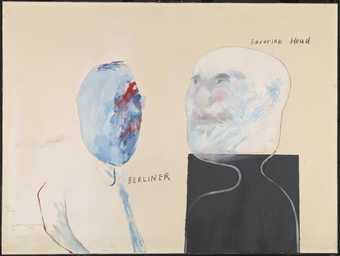
On loan
Museum of Contemporary Art Tokyo (Tokyo, Japan): David Hockney, in collaboration with the Hockney Studio
- Artist
- David Hockney born 1937
- Medium
- Acrylic paint on canvas
- Dimensions
- Support: 2125 × 3008 mm
- Collection
- Tate
- Acquisition
- Presented by the artist 2014
- Reference
- T14098
Summary
George Lawson and Wayne Sleep 1972−5 is one of the last paintings from a sequence of large double portraits that occupied David Hockney between 1968 and 1977, although the artist never fully finished it. The ten-foot, landscape-format painting shows the antiquarian book dealer George Lawson sitting on a stool at a clavichord placed against a wall. His right hand holds down a key on the keyboard, but his body is turned away from the clavichord and towards the open window to the left of the painting − he thus appears in profile and marks the centre of the painting. Immediately to the left of the clavichord and adjacent to the window is a doorway with the door ajar; in this opening stands the ballet dancer Wayne Sleep, leaning against the doorframe by his left elbow and with his legs crossed − a casual contrapposto pose that is echoed by the curtains pulled to the side of the window. The casual pose and clothing of Sleep − T-shirt, white trousers and correspondent shoes − is in contrast to the more formal green suit, bow tie and polished black shoes worn by Lawson. The setting for the painting was Lawson’s flat in Wigmore Place, London (https://www.tate.org.uk/tate-etc/issue-36-spring-2016/sitting-hockney, accessed 4 February 2020). The note played on the clavichord – initially recalled by Sleep as being an A-Flat − was the punning title that Lawson suggested to Hockney for the painting. However, he later recalled that the note was in fact a G: ‘According to Wayne, I’m playing an A-flat on the clavichord I’m sitting beside – I wanted to call the painting A Flat, you see – but now I can see perfectly well that it’s a G. I would play this note when I was sitting for the portrait. I can hear it now.’ (Quoted at https://www.tate.org.uk/tate-etc/issue-36-spring-2016/sitting-hockney, accessed 4 February 2020.)
Sleep was one of the star performers of London’s Royal Ballet and Hockney had been introduced to him in 1967 by Lindy Dufferin (the wife of Sheridan Dufferin, the business partner of Hockney’s dealer Kasmin) and they had become friends. It was Hockney who later introduced Sleep to Lawson, who said of Hockney’s portrayal of the dancer that ‘the pose was interesting. Wayne was looking at me at the keyboard, standing and listening. I think it was a nice conceit that he had a ballet dancer not moving just listening.’ (Quoted in Sykes 2011, p.273.)
George Lawson and Wayne Sleep contains many of the themes that occupied Hockney in tackling the subject of a double portrait, foremost among which are a narrative of friendship and a depiction of a relationship that is often compared to the Annunciation − ‘there is always somebody who looks permanent and somebody who’s a kind of visitor’ (Stangos 1976, p.204). Here Wayne Sleep is the visitor, a role that is underlined by his proximity to both door and window. In this painting, as with many of the other double portraits − a sequence that includes American Collectors (Fred and Marcia Weisman) 1968 (Art Institute of Chicago); Christopher Isherwood and Don Bachardy 1968 (private collection); Henry Geldzahler and Christopher Scott 1969 (private collection); Le Parc des sources, Vichy 1970 (private collection); Mr and Mrs Clark and Percy 1970–1 (Tate T01269); Gregory Masurovsky and Shirley Goldfarb 1974 (private collection); My Parents and Myself 1975 (destroyed) and My Parents 1977 (Tate T03255) − the sense of the annunciation leads to a separation or distance between the figures that, the historian Marco Livingstone has suggested, lends these portraits psychological charge: ‘the sense of struggle between the impulse to connect with another human being and the need to remain separate … is now treated with greater directness. These observations are achieved through purely pictorial means, both through the gestures of the participants and by means of the formal division of the architectural settings into compartments or separate spaces.’ (Livingstone 1996, p.144.) George Lawson and Wayne Sleep is similarly divided up into two pictorial areas or domains. The main area of the painting is the main room of Lawson’s stark Wigmore Place flat, dominated by the expanse of bare wall that occupies the right half of the painting; Sleep’s domain is the red carpeted room that we see through the doorway, with papers on the floor, and significantly the red carpet extends into Lawson’s domain to run along the edge of the room under the clavichord.
Hockney spent six months in 1972 on the painting, trying to finish it in time for his exhibition in December at Kasmin’s gallery in London, repainting it many times. His struggle with the painting revolved both around his attitude to naturalism and his use of acrylic paint. Following on from Mr and Mrs Clark and Percy, he was not only painting the figures in a much more naturalistic way than before, he was also concerned to unite the composition and depict the relationship as one framed by the London light that illuminated first Sleep and then Lawson, fading towards the righthand corner of the room. Hockney has described how he constantly felt the need to repaint large areas of the painting:
all I was doing was painting a wall with the light coming in on the left, so the wall gets darker and darker. I mixed colours for the wall, put them on a palette and walked along going from light to dark, while Mo kept it damp with lots of water sprays; and all the time your one fear is that it will dry and you will have to try and blend the other colour in, while keeping it still wet so you can do the next.
(Quoted in Stangos 1976, p.125.)
Lawson later recalled the difficulties Hockney faced with the painting:
David struggled to get the light right, and he said it was one of the hardest things he’d ever had to do – to paint just a blank, sort of distempered wall. He had at one point put copies of the New Temple Shakespeare in as a reference to the painterly convention whereby one shows the profession of the sitter in the objects surrounding them; these were a nod to my profession as a bookseller. There is a rather odd blue blob in the bottom right-hand corner of the canvas now that was originally part of a two-volume box-set of the Oxford English Dictionary, which was in the painting at one stage along with the books. The blue bit of line there is what remains of it. He’s left it in – it’s quite strange, but it feels deliberate.
(George Lawson quoted at https://www.tate.org.uk/tate-etc/issue-36-spring-2016/sitting-hockney, accessed 4 February 2020.)
Hockney also moved the clavichord to his studio so that Lawson could pose for him there and even had a large cut out made of Lawson to help him with the placement of the figure. However, he felt that the painting had defeated him and in the end it was not exhibited; he abandoned the painting in 1973 as unfinished, although he briefly resumed working on it in 1975, before again abandoning it. He later admitted:
The reason I abandoned it was because of all the problems I began to find in naturalism, and they took me a long time to sort out. In a way, I spent a long time on pictures that I later grew to hate a bit − I was wasting my time there … I found moving away from [naturalism] harder than moving away from anything else.
(Quoted in Peter Webb, Portrait of David Hockney, London 1990, p.206.)
Further reading
Nikos Stangos (ed.) David Hockney by David Hockney, London 1976, reproduced p.273.
Marco Livingstone, David Hockney, London 1996, reproduced p.161.
Christopher Simon Sykes, Hockney: The Biography, Volume 1 1937−1975, London 2011.
Wayne Sleep and George Lawson, ‘Sitting for Hockney’, Tate etc., 11 February 2016, https://www.tate.org.uk/tate-etc/issue-36-spring-2016/sitting-hockney, accessed 4 February 2020.
Andrew Wilson
November 2013, updated February 2020
Does this text contain inaccurate information or language that you feel we should improve or change? We would like to hear from you.
You might like
-
David Hockney 3. The Start of the Spending Spree and the Door Opening for a Blonde
1961–3 -
David Hockney Myself and my Heroes
1961 -
David Hockney Lithographic Water Made of Lines, Crayon and Two Blue Washes Without Green Wash
1978–80 -
David Hockney Pembroke Studio with Blue Chairs and Lamp
1984 -
David Hockney Beautiful and White Flowers
1966 -
David Hockney Mr and Mrs Clark and Percy
1970–1 -
David Hockney Study for ‘Mr and Mrs Clark and Percy’
1970 -
David Hockney Study for ‘Mr and Mrs Clark and Percy’
1970 -
David Hockney Man in Shower in Beverly Hills
1964 -
David Hockney A Bigger Splash
1967 -
David Hockney My Parents
1977 -
David Hockney The Third Love Painting
1960 -
David Hockney Tea Painting in an Illusionistic Style
1961 -
David Hockney Study for Doll Boy
1960 -
David Hockney The Berliner and the Bavarian
1962

